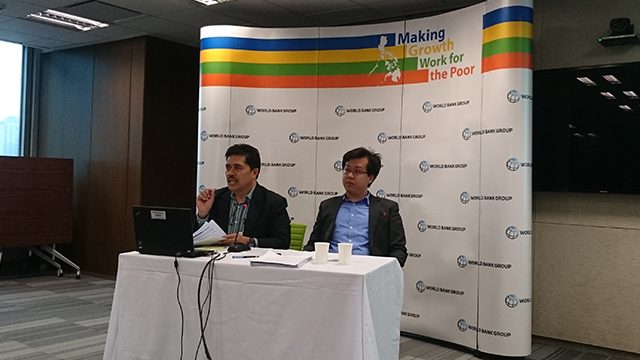SUMMARY
This is AI generated summarization, which may have errors. For context, always refer to the full article.

MANILA, Philippines – The World Bank has cut anew its growth forecast for the Philippines to 5.8% for 2015 due to slower than expected first half growth, and weak exports brought about by a slowing global economy.
The latest forecast is lower than its projection in April this year of gross domestic product (GDP) growth of 6.5% for both 2015 and 2016. (READ: World Bank cuts PH growth forecast to 6.5% for 2015)
“Near-term economic growth will remain robust and is projected to improve from 5.8% in 2015 to 6.4% in 2016 and 6.2% in 2017 while growth in the medium-term remains positive,” said World Bank Philippines Senior Economist Karl Kendrick Chua in a statement read on Monday, October 5 by representatives at the launch of the latest Philippine Economic Update.
The lower near-term growth projections takes into account risks from a slower economic recovery in developed nations, rising interest rates, China’s slowdown, and the impact of El Niño, as well as delays in domestic reforms.
Slower recovery of the US, Euro Area, and Japan will limit the growth of Philippine exports, and that the Philippines needs to start raising productivity to reduce unit labor costs, Chua said.
The latest report also assumed a gradual increase in interest rates by the US Federal Reserve that will begin in the coming months.
While the report pointed out that the increase has been anticipated and is likely to be orderly, there is still a risk that markets could react sharply causing currencies to depreciate, capital inflows to fall, and liquidity to tighten.
Growth drivers
The chief concern for the Philippines is that this could negatively impact the cost of financing both for the public and private sectors in the country, Chua said.
A stronger El Ninõ may also hurt agriculture severely which could result in higher prices and slower overall growth.
Growth in the second half of 2016, however, is projected to improve from a slow first half as government spending is ramped up.
Record low inflation and the increasing implementation of public-private partnerhips (PPPs) projects could further strengthen growth, Chua said.
The chief drivers are private consumption and a strong services sector.
Chua added that with the private domestic demand growing by an average of 6.9% since 2010, realizing the administration’s growth target of 7%-8% will primarily hinge on its ability to increase public spending.
Regional projections
Among the bigger Southeast Asian countries, the Philippines and Vietnam are expected to be the stronger performers as weak commodity prices hobble growth in oil exporters Indonesia and Malaysia.
The latest Philippine growth projections was part of the World Bank’s release of the East Asia and Pacific update, which situated the Philippines as a relatively good performer in the region. (READ: PH economy still a bright spot in Asia)
Apart from the Philippines, the 14-country forecast also includes China, Indonesia, Malaysia, Thailand, Vietnam, Cambodia, Laos, Myanmar, Mongolia, Fiji, Papua New Guinea, the Solomon Islands, and East Timor.
The World Bank sees developing Asia to grow by grow 6.5% in 2015, slightly down from 6.8% last year.
Of this growth, China’s economy is expected to grow at about 6.9% this year and moderating to 6.7% next year and 6.5%in 2017, as its economy continues to shift toward a model more dominated by domestic consumption and services, which the multilateral organization said implies a gradual reduction of growth.
The rest of developing East Asia is expected to grow 4.6% this year, similar to last year.
World Bank Chief Economist for East Asia and the Pacific Sudhir Shetty shared that despite this slowdown, East Asia remains one of the main growth drivers of the world economy, accounting for about two-fifths or 40% of global economic growth.
The multilateral agency pointed out that the global environment remains challenging as the recovery in developed economies remains gradual. Global trade is growing at its slowest pace since 2009, and the widespread slowdown in developing countries has intensified.
“The region’s growth is expected to slow because of China’s economic rebalancing and the pace of the expected normalization of the US policy. These policies could generate financial volatility in the short term but are necessary adjustments for sustainable growth in the long term,“ Shetty said.
These reforms, World Bank Regional VIce President Axel Van Trotsenburg said in the report include regulatory improvements in finance, labor, and product markets, as well as measures that enhance transparency and accountability. These policies will reassure investors and markets, and help sustain growth that can help lift people out of poverty. – Rappler.com
Add a comment
How does this make you feel?
There are no comments yet. Add your comment to start the conversation.